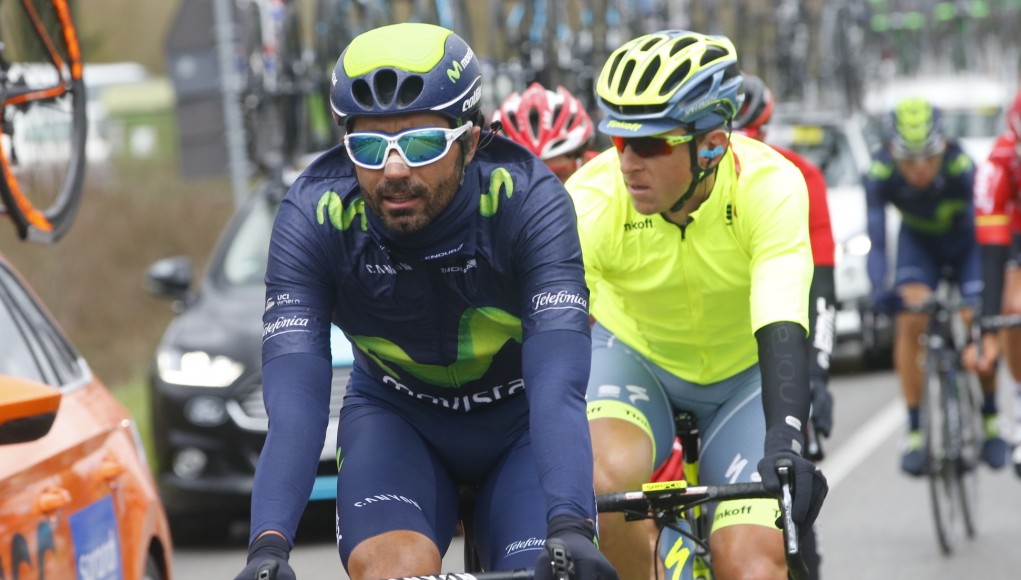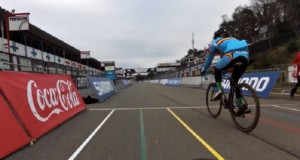Following on from the incident at Sunday’s Paris-Roubaix where Francisco Ventoso was injured after crashing and landing on a disc brake, the Spanish rider has posted an open letter about his opinions on the use of disc brakes and their potential for injury.
Ventoso’s letter is below:
I’ve spent thirteen years in the pro cycling peloton and another thirteen moving up the ladder in youth categories. That makes it 26 years on my bike, training every day, enjoying what I like most, my passion. Since I was six, I’ve enjoyed racing, and I continue to do so. I’m so happy to have turned my vocation into a dream job.
Just like in any other sport, cycling has evolved in many technical aspects. However, it has not done so in others in a way we’d all have liked.
Through all these years, I’ve witnessed many improvements on different parts of the bike and cycling apparel. We started off with steel, then aluminum, and later on, carbon. That last one came here to stay, since it was as rigid as we needed while also offering lightness. We’ve also stopped using toeclips for clipless pedals, much more comfortable, effective and secure. Days are long gone when we used hairnet helmets: modern ones are now lighter, beautiful to the eye and offer absolute security guarantees when you use them.
I’ve also seen very important improvements on gearing. My first bike had one chainring and three sprockets; nowadays, we use two chainrings, even three, and 11 sprockets… and I’m certain it won’t end there. Technology evolution has been a sort of trial and error: getting to this point hasn’t been easy. I remember how easily chains were broken when we first used ten sprockets: links that broke, because of materials still not as resistant as it was required… it still happens today. We could also talk about the revolution that has brought the electronic shifting. When it was first shown and used, we all were surprised and made early judgments: it’s not necessary, it might not work well, carrying batteries seems wrong, having to connect your bike to AC is bonkers… And now, we can’t imagine our bikes without it.
My point is: two years ago, we started seeing disc brakes put on cyclocross bikes, and the rumour was that there could be a chance that they be tested in road cycling events.
Beforehand, I want to make this clear: I’m so in favor as anyone else that cyclocross professionals or participants in sportives enjoy the advantages of disc brakes during their rides.
But then, there’s pro road cycling events. Was there really anyone who thought things like Sunday’s wouldn’t happen? Really nobody thought they were dangerous? Nobody realized they can cut, they can become giant knives?
At Paris-Roubaix, only two teams used them. With eight riders each, that makes it sixteen, carrying a total 32 disc brakes into the peloton. Let me take you to 130km into the race: into a cobbled section, a pile-up splits the field, with riders falling everywhere. I’ve got to break but I can’t avoid crashing against the rider in front of me, who was also trying not to hit the ones ahead. I didn’t actually fall down: it was only my leg touching the back of his bike. I keep riding. But shortly afterwards, I have a glance at that leg: it doesn’t hurt, there’s not a lot of blood covering it, but I can clearly see part of the periosteum, the membrane or surface that covers my tibia. I get off my bike, throw myself against the right-hand side of the road over the grass, cover my face with my hands in shock and disbelief, start to feel sick… I could only wait for my team car and the ambulance, while a lot of things come through my mind.
Just a stroke of bad luck? I don’t thing so: few kilometers later, one of the thoughts I had sitting in the gutter becomes real.
15km after my incident, Nikolas Maes, a rider from Etixx-Quick Step, comes into the very same ambulance I’m sitting in. There’s a deep wound in his knee, produced by another disc, one of those 32. One question comes inevitably and immediately to one’s mind: what will happen when 396 discs get into a race where 198 riders ferociously battle for position?
Disc brakes should have NEVER arrived into the peloton, not at least as we know them right now. I haven’t met any rider who has run out of braking power with traditional brakes; I haven’t known anyone who didn’t see his wheels skidding when you brake with all power you’ve got, no matter traditional or disc brakes. Then: why using them?
Conversely, there are lots of problems to change wheels after a puncture; added trouble for neutral service, which has to carry three or four different sets of wheels to help you out in case your team car is not around… and the most worrying thing, as I stated before, is that disc brakes in its actual concept are giant knives, ‘machetes’ when crashing against or crashed by them at a certain speed. And in some points, we reach 80, 90, 100 kilometres per hour.
I’ve been lucky: I didn’t get my leg chopped off, it’s just some muscle and skin. But can you imagine that disk cutting a jugular or a femoral artery? I would prefer not to.
All of this happens because the international riders’ association –the CPA–, national riders’ associations, international and national feds, teams and, above all of them, OURSELVES, PROFESSIONAL RIDERS, are not doing anything. We always think that it’s not a problem if it doesn’t happen to ourselves. We always wait for horrible things to happen in order to take measures. Sooner or later, it could happen to anybody: it’s a matter of probability, we’ve all got the same. Pro riders should take a look beyond our own belly. Others tell us what we should do, but we just can’t forget WE’VE GOT THE POWER TO CHOOSE, AND WE SHOULD MAKE A CHOICE.
Disks produce cuts. This time it was me; tomorrow, it can be more serious and happen to others.










How many recorded ‘disc related’ injuries have been recorded in mountain biking over the years? Very very few I reckon.
True, however mountain bike racing doesn’t have the riders in such close quarters.
Xc racing is not that different to Road at times. Riders also collide with their own bikes all the time also.
Very rare for more than one or two MTB’s to go down together, and when they do the speeds are far slower. Road bikes are projectiles, I wouldn’t want one coming my way at 80km with disc showing, let alone a whole pelaton.
How often do you see a pile up in mountain biking that you see in road cycling?
Yeah, how many crashes in mountain bike racing involving half of the peleton???? 🙂
It’s not a fair to compare disc brake accident stats in XC and road. You just don’t get the same kind of high speed pile ups in size nor frequency that you see in road racing.
You know it’s not 100% applicable to compare mtb with Road, BUT in all the years of discs in mtb and literally next to zero evidence of riders getting cut by rotors. I’ve crashed and been tangled in my bike more times than I can think k of, and I still have all my arms and legs attached! Frankly the chairing is a bigger hazard! Disc brakes give better, more consistent modulation and power in more riding conditions.
Brendan Whelan
Whatever about the merits of disk v calliper, he’s right about them being a solution to a non-existent problem.
How hard is it to machine a round edge on the disc caliper? Seems like an easy solution. Should I patent that, the safety disc?
Personally I don’t race so discs would be find for me and other cyclos and mtbers. However pro/elite road should just take a page out of track racing and keep the bike to the strictest minimum to lower risk of injury in inevitable crashes. 396 red hot spinning bacon slicers between your legs in a peloton of 198 riders flying over cobblestones at 50/60kmph does sound a bit risky…
Gary Simpson
Maybe takeaway the roads too all those bloody broken collar bones- I actually want a disc brake burn mark on my calf, it’s got to be better than those frigging ironman branding’s you all have
It can be arranged. I’ll lend John Swallow my cross bike and get him to ride near you in his usual reckless fashion.
Can I pick the disc pattern ?
I’m sure there is a way to make the brakes safer. Some sort of rotor guard added to the bike should make them safer. Personally, I want disc brakes on my next road bike as I know that they provide more braking power and are easier to actuate.
[Alex — you’re talking thro’ your backside DISCS will not stop you quicker — by pulling your brake lever hard you’ll stop just as quick with calipers but unfortunately your tyre will lock & loose adhesion with the road surface just as it will with discs — it’s all about the the tyre to road surface.
Scott Marshall
A “solution” to a non existing problem but causeing several new problems . A classic market segmentation driven by marketeers not by need . Not cool …
I hate the look of them on a road bike any way, but think the brakes I have do a great job, its all about marketing and money, if the Pro’s use them the rest of us will follow, so its new frame new wheels to change with the disc brakes. Listen to Francisco these guys no best !!
If you look at the scares there on Twitter somewhere it looks more like a chainring!! You can see where the individual teeth indents the skin!!
Very interesting read this one Ben Stoneley Ed Dursley Steve Wilts Steve Darby Steven Clarke Nick Stinton Simon Garrett
[…] today, Ventoso posted a detailed, open letter providing details about his accident and his concerns with the use of disc brakes in professional cycling. The Spanish rider was left […]
1 Question – He was avoiding an accident and didn’t fall off, and he says he rode into the back of the bike in front – How did the outside of his left leg hit the rear dics of the bike in front, disc’s are on the left, i,m not saying its not possible or he’s lying but if he didn’t know it had happened how does he know its a disc cut – his knee would have to have gone through the spokes ?
I never liked disk brakes. He’s right.
I approve the message